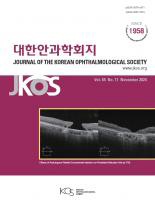- 영문명
- Indications of Brain Magnetic Resonance Imaging in Pediatric and Adolescent Patients with Non-Traumatic Visual Disturbance
- 발행기관
- 대한안과학회
- 저자명
- 이기범(Kibum Lee) 조권희(Gwon Hui Jo) 이성은(Seong Eun Lee) 최미영(Mi Young Choi)
- 간행물 정보
- 『대한안과학회지』volume66,number9, 372~380쪽, 전체 9쪽
- 주제분류
- 의약학 > 의학일반
- 파일형태
- 발행일자
- 2025.09.30
4,000원
구매일시로부터 72시간 이내에 다운로드 가능합니다.
이 학술논문 정보는 (주)교보문고와 각 발행기관 사이에 저작물 이용 계약이 체결된 것으로, 교보문고를 통해 제공되고 있습니다.

국문 초록
목적: 외상 경력 없이 발생한 시각장애로 안과 외래에 내원한 소아청소년 중 뇌 자기공명영상(magnetic resonance imaging, MRI)에서 뇌병변이 발견된 경우의 안과 검사 소견을 분석하여, 뇌 MRI 촬영의 적응증이 될 임상 소견이 있는지를 알아보고자 하였다.
대상과 방법: 비외상성 시각장애의 원인을 알아보고자 뇌 MRI 촬영을 위해 의뢰된 19세 미만 환자 63명의 의무기록을 분석하였다. 시각장애 종류, 최대교정시력, 동공반사, 눈운동, 안저, 빛간섭단층촬영(optical coherence tomography, OCT), 시야, 뇌 MRI 결과를조사하였다. 시각장애에 합당한 뇌 MRI 소견이 있는 경우에 뇌 MRI 양성이라고 정의하였으며, 뇌 MRI 양성 여부에 따라 임상 양상에차이가 있는지를 분석하였다.
결과: 전체 63명의 평균 나이는 8.6세이었으며, 시각장애 중 시력저하가 35명으로 가장 많았다. 63명 중 8명(12.7%)에서 뇌 MRI 양성이었으며, 8명 중 4명이 뇌종양이었다. 뇌종양으로 시력이 저하된 3명 중 한 명은 구심동공운동장애가 있었고, 3명 모두 시신경이창백하였으며, OCT에서 시신경 두께가 감소하였다. 외사시로 내원한 뇌종양 환자 한 명은 두 눈의 상전장애와 시신경부종이 있었다. 구심동공운동장애, 창백한 시신경, 시신경섬유층 두께 감소가 뇌 MRI 양성 여부와 통계학적으로 의미 있는 연관성이 있었다.
결론: 외상 경력 없이 발생한 시각장애로 안과에 내원한 소아청소년의 12.7%에서 뇌 MRI 병변이 있었으며, 이 중 50%가 뇌종양이었다. 이들에서 구심동공운동장애, 시신경이 창백하거나 시신경섬유층 두께가 감소한 소견을 보인다면 뇌 MRI를 촬영할 것을 권유한다.
영문 초록
Purpose: We investigated the ophthalmologic findings in pediatric and adolescent patients presenting with non-traumatic visual disturbances who were subsequently found to have significant intracranial lesions on brain magnetic resonance imaging (MRI). In addition, we identified associated clinical factors that may guide the decision to perform brain MRI in such cases.
Methods: We retrospectively reviewed the medical records of 63 patients aged ≤ 18 years who underwent brain MRI to evaluate the etiology of non-traumatic visual disturbances. Data collected included visual disturbance type, best-corrected visual acuity, pupillary light reflex, ocular movement, fundus photo, optical coherence tomography, visual field and brain MRI findings. MRI findings were classified as positive if the detected intracranial lesions could account for the patient’s visual symptoms. Ophthalmologic features were compared between patients with MRI-positive and MRI-negative findings to identify predictive clinical indicators.
Results: The mean age of the patients was 8.6 years. The most common presenting symptom was decreased vision, reported in 35 patients. Brain MRI revealed positive findings in eight patients (12.7%), including four cases of brain tumors. Of the three patients with brain tumors who presented with decreased vision, one had a relative afferent pupillary defect (APD), whereas all patients exhibited pale disc and reduced retinal nerve fiber layer (RNFL) thickness. One patient with a brain tumor presented with exotropia, bilateral limitation of elevation, and disc edema. The presence of APD, pale disc, and decreased RNFL thickness exhibited a statistically significant association with positive brain MRI findings.
Conclusions: Positive brain MRI findings were identified in 12.7% of pediatric and adolescent patients who presented with non-traumatic visual disturbances, with half of these cases attributed to brain tumors. Brain MRI should be significantly considered in patients with APD, pale disc, or reduced RNFL thickness.
목차
대상과 방법
결 과
고 찰
REFERENCES
해당간행물 수록 논문
참고문헌
관련논문
의약학 > 의학일반분야 BEST
더보기의약학 > 의학일반분야 NEW
- Effects of a health coaching program based on Cox’s interaction model in older adults with diabetes mellitus in Korea: a quasi-experimental study
- 국내 거주 베트남 여성의 인유두종바이러스 백신접종 의도의 영향요인: 횡단적 상관관계 연구
- Adherence-based experiences with a personalized self-care program for type 2 diabetes in South Korea: a mixed-methods study
최근 이용한 논문
교보eBook 첫 방문을 환영 합니다!

신규가입 혜택 지급이 완료 되었습니다.
바로 사용 가능한 교보e캐시 1,000원 (유효기간 7일)
지금 바로 교보eBook의 다양한 콘텐츠를 이용해 보세요!



